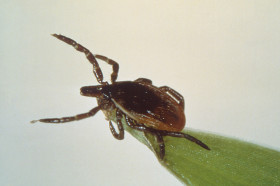May is Lyme Awareness month. And it is indeed time to be aware. Thanks to El Niño, it’s a wetter Spring than we’ve had in several years. That means we have lots of green grass, damp leaf litter, and overgrown trails and paths. It also means the ticks are out. And early spring means nymph season — these nymphs are young ticks, not much bigger than a poppy seed … the kind that are easy to miss with a quick glance.

The good news is that ticks can’t fly, jump, or even run. But they do “quest” — they hang out on leaves, blades of grass, and branches, tiny legs poised to grab onto a warm body passing by. Ticks need to feed in order to progress to the next life stage and perching ready to grab a free ride (and meal!) on an unwitting passerby is how they ensure their survival.
When hiking or biking in the woods, if you keep to the center of the trail and avoid bushwhacking and brushing up against high grasses or other vegetation, your risk of picking up a parasitic passenger is pretty low. Once you leave the trail for a pit stop, however, the risk rises exponentially. Ticks are carried by deer and other small mammals that also like to use the trails so the highest concentration of ticks is often close to trails.